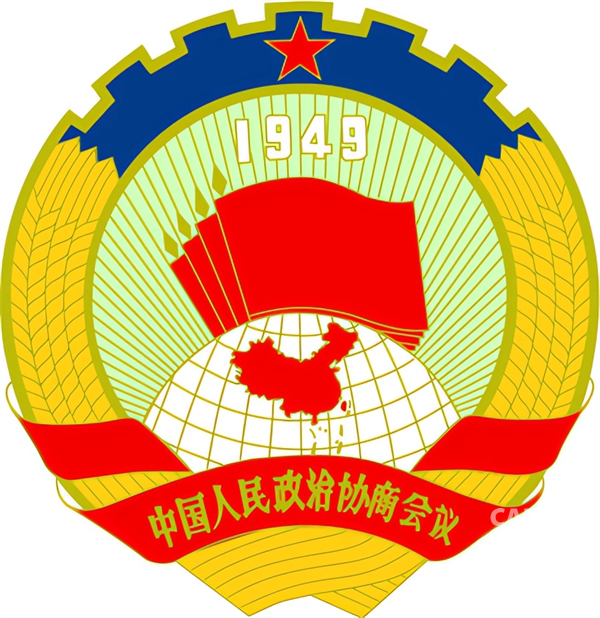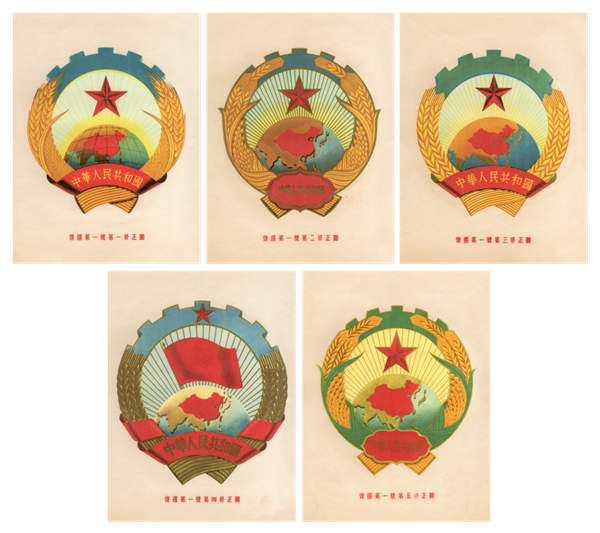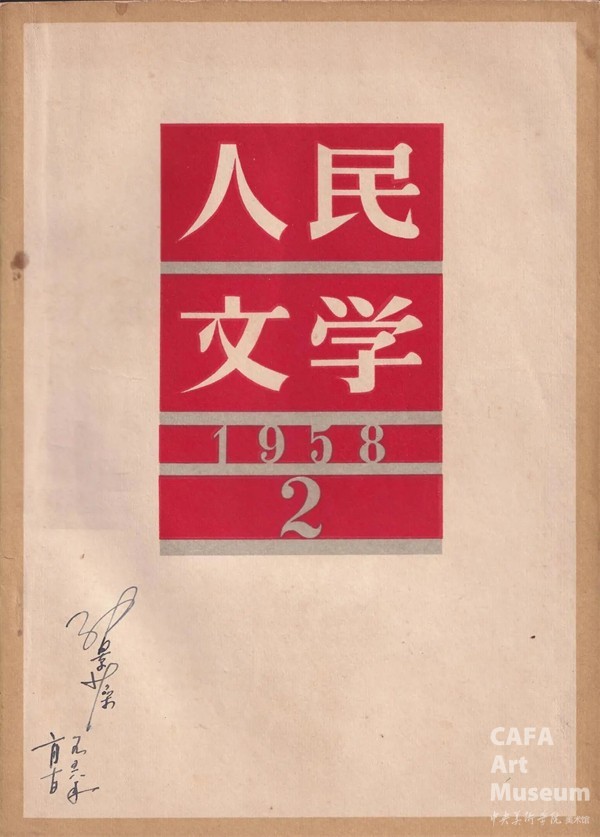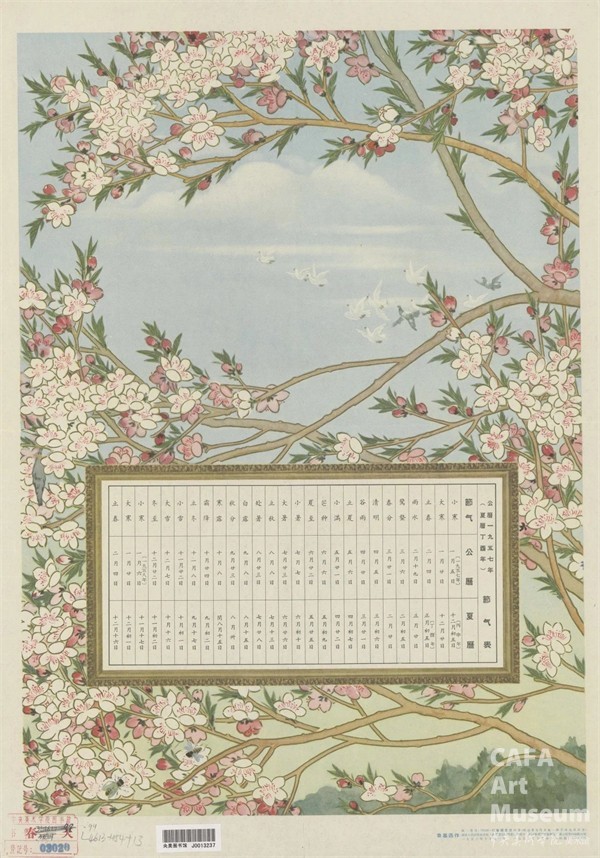

“新中国设计的诞生(1945-1959)”正在中央美术学院美术馆2层A展厅展出。本次展览以20世纪40、50年代中国社会的巨变为背景,围绕1945-1959年之间的中国设计与中国现代文明和历史文化之间的关系,从“前进 前进”“视觉革命”“积极的工业化”“人民的时尚”“民族 科学 大众”五个板块,以实物、图像、影像和文献等多种途径展出作品二百余件,系统地呈现中国现代设计史发展中的这个重要阶段。本次推送为大家呈现板块二“视觉革命”的深度阐释。
板块介绍


新中国设计的诞生,在视觉层面上,首先表现为以国旗、国徽为核心的国家视觉形象的确立。齿轮、麦穗、五角星等一系列符号语汇,使新中国设计的图形语言焕然一新,其影响也迅速由政治领域而延展到日常生活。其次,表现为与国家的大政方针密切配合的宣传性图像和装帧新风格的日渐成熟。就中国的现代设计运动而言,这无疑是一场内容广泛的视觉革命。“视觉革命”下设三个主题:1、为新中国造型;2、宣传与鼓舞;3、装帧新风格。

《和平》,张道一,宣传画,77×53cm,1956年,中央美术学院图书馆藏

《中华人民共和国成立十周年(第四组)》纪念邮票的设计手稿,周令钊,印刷品,1959年,中国邮政邮票博物馆藏

《漫画》第108期,人民美术出版社,封面设计:周令钊,书籍,20.5×26cm,1958年3月8日,私人收藏
部分展品阐释
1. 政协会徽
(1)政协会徽的诞生
1948年,在人民解放战争节节胜利的形势下,中国共产党及时把建立新中国提上议事日程。1948年4月30日,中共中央书记处扩大会议讨论通过中共中央庆祝五一节口号,提出“为着打倒蒋介石建立新中国而共同奋斗”,号召“各民主党派、各人民团体、各社会贤达迅速召开政治协商会议,讨论并实现召集人民代表大会,成立民主联合政府”。[1]
1949年6月,新政治协商会议筹备会在北平成立并召开第一次全体会议。1949年7月,新政治协商会议筹备会秘书长办公室第五次工作会议决定设计政协会徽,并明确会徽的含义为:无产阶级领导的以工农为基础的民主阶层大团结。

中国人民政治协商会议会徽设计稿,张仃、周令钊,复制件,1949年
新政协筹备会把会徽设计工作交给了时任文娱布置科科长和中南海俱乐部主任的钟灵。在钟灵的组织下,新政协的会徽确定了由华北大学三部美术系的张仃和国立北平艺术专科学校的周令钊设计的图案(中华人民共和国成立后,华北大学三部美术系、国立北平艺术专科学校合并为中央美术学院)。经新政协筹备会常委会主任毛泽东批准,政协会徽在1949年9月21日开幕的中国人民政治协商会议第一届全体会议上正式使用。
(2)政协会徽设计的规范化
2016年9月,全国政协办公厅开始重新制作人民大会堂大礼堂召开政协全体会议时悬挂的政协会徽,具体设计和监制工作交由中央美术学院承担。中央美术学院组成了由院长范迪安领衔的设计团队,由2008年奥运会奖牌设计者杭海教授具体负责,工作内容为设计会徽立体模型,规范会徽图案中的各项构成,编制符合当前工艺水平的政协会徽制作规范和技术标准。

中国人民政治协商会议会徽,设计:张仃、周令钊,印刷品,1949年
2016年11月,中央美术学院设计团队和全国政协办公厅秘书局有关工作人员就此工作专程拜访了周令钊老先生。时年97岁的周老先生对中央美术学院重新绘制的政协会徽图案一共提出五条建议:一是会徽缎带的边沿应该由白色改为红色;二是会徽中的四面红旗应该有飘动感,上边沿应有一定的弧度;三是会徽的下部外轮廓的金线应该加粗,表现出会徽的整体性;四是“中国人民政治协商会议”字体沿用原来的字体,颜色应该用黑色,与会徽上部齿轮深蓝色相呼应,字体可稍微加粗;五是中国地图与红旗太接近,要有一定的留白。中央美术学院设计团队高度重视周令钊老先生的意见,除“‘中国人民政治协商会议’字体颜色应该用黑色”的建议未采纳外,基本吸纳了周先生的意见,形成了新的规范的政协会徽图案。据此图案,中央美术学院设计了会徽立体模型,于2017年9月经十二届全国政协第二十六次秘书长会议审议通过。[2]
(文/凌晨)
2. 国旗
1949年6月16日,周恩来在中南海主持了新政治协商会议筹备会常务委员会第一次会议,决定在筹备会常委会下设六个小组,其中拟定国旗、国徽及国歌方案均由第六小组负责。7月14日,《征求国旗国徽图案及国歌辞谱启事》开始陆续在《人民日报》、《天津日报》、《新民报》、《大众日报》、《光明日报》等各大报纸刊登,并获得了热烈的反响,在一个月内,共征集到国旗设计稿1920件,图案2992幅;国徽设计稿112件,图案900幅;国歌632件,歌词694件。应征者涉及各个阶层、职业,男女老幼都有。

曾联松应征国旗设计稿,曾联松,复制件,1949年
经过多次严格地讨论与审议,1949年9月,第六小组从国旗应征稿件中选出共38幅编印成《国旗图案参考资料》,设计者包括曾联松、张仃、钟灵、郭沫若、莫宗江、萧淑华等人,分别以“复字第1号”至“复字第38号”顺序编号,提交全体会议代表审阅。其中,将由曾联松设计的“复字第32号”大五星图案中的镰刀锤子图案去掉。第六小组在9月21日给主席团的报告中对38幅设计稿进行了分类评价。9月25日晚,毛泽东、周恩来在中南海丰泽园主持座谈会,邀请郭沫若、沈雁冰、田汉、徐悲鸿、艾青、梁思成等参加,听取关于国旗、国徽、国歌等的意见。会上,毛泽东认为曾联松设计的五星红旗图案表现了革命人民的大团结。并说:“现在要大团结,将来也要大团结。因此,现在也好,将来也好,又是团结又是革命。”

国旗制法说明,1949年9月29日《人民日报》刊登,复制件,1949年,《中华人民共和国国旗国徽国歌档案》收录
1949年9月29日,《人民日报》刊登国旗图案、《国旗制法说明》以及《义勇军进行曲》词曲。9月30日,中国人民政治协商会议第一届全体会议胜利闭幕。10月1日,中华人民共和国举行开国大典,在代国歌《义勇军进行曲》声中,毛泽东亲手升起第一面五星红旗。[3]
(文/凌晨)
3. 国徽

张仃、钟灵国徽应征图案复选修正稿,张仃、钟灵,复制件,1950年,中国政协文史馆提供
中华人民共和国国徽的设计,集中了当时中国一流的美术和设计专家的才智,是多方参与、阶段性完成、集体创作的结晶。1950年10月23日,清华大学营建系国徽设计组成立,梁思成等人提出《拟制国徽图案说明》。同时,中央美术学院在张仃的领导下页成立了国徽设计组。经过几个月的努力,两个国徽设计组拟制了两种不同的方案,梁思成等人的设计以民族形式的玉璧为主要内容,张仃等人设计的以天安门为主要内容。[4]但其共同之处在于均基于环绕样式构图。

中央美术学院国徽设计小组国徽设计方案,张仃、周令钊等,复制件,1950年,中国政协文史馆提供
中央美术学院国徽设计小组的方案,在主体创意方面起到了奠基性作用,其方案中的主要构件后来成为国徽的基本元素。[5]央美国徽设计小组在几轮方案中的观点总结如下:1.坚持以天安门为主体;2.面向民间的设计立场,比如强调“写实是通俗的,不是庸俗的。”3.进一步解释了关于历史传统的继承问题,指出历史的继承是有选择的,“继承能服务人民的部分,批判反人民的部分”、[6]“不是一味模仿古人,无原则歌颂古人,而是‘推陈出新’。”[7]这些观点非常符合央美组的民间立场,也可以看出这个团队中的革命气息和现代性的思想。[8]在1950年展开的第二轮国徽设计工作中,中央美术学院国徽设计小组提供了两套方案,其中这个以天安门为核心、有“五星”概念的设计稿是由周令钊先生主创并绘制完成的。另一个将天安门形象绘制得更具体的方案则由张仃主导设计。
1950年6月23日,全国政协一届二次会议通过了国徽图案及对图案的说明,并提请中央人民政府委员会核准公布。1950年9月20日,中央人民政府主席毛泽东发布《中央人民政府命令》,公布国徽及图案说明,《人民日报》等予以刊登。至此,代表着新中国象征的中华人民共和国国旗、国徽、国歌全部产生。
(文/凌晨)
4. 刘岘

《百花齐放》,作者:郭沫若 封面设计:刘岘,书籍,16.8×21.5cm,1959年,私人收藏
1956年4月28日召开的中央政治局扩大会议上,毛泽东在总结讲话中强调了学术与艺术的重要性,强调文艺工作者们要积极创作好的作品,形成百花齐放百家争鸣的文艺局面。为宣传“百花齐放”的方针,1958年,郭沫若用了10天时间,选择100种花为题目,写了101首咏花的新诗[9]。
就木刻来说,为1958年人民日报出版社出版的平装本《百花齐放》作插图的木刻家共有八人[10],其中提供幅数最多的便是刘岘,共有三十三副,再加上一副郭沫若的肖像。[11]而这本精装本《百花齐放》由上海文艺出版社1959年出版,它既是郭沫若的诗集,也是刘岘的木刻画集,因为其收录了刘岘单独为这101首诗所作的101副花卉插图。为了每一张插图木刻的准确与生动,刘岘常去花房实地考察花卉实体,并参考相关典籍学习参考,以严谨多变的刀法、微妙的线条,表现出了枝叶扶疏、繁花竞放的花卉世界。[12]


《百花齐放》内页,刘岘作
设计者介绍
刘岘出生于1914年,是著名的书籍装帧设计家。早年他与新波一起创办未名木刻社,后去延安,为发展人民文学和人民美术事业,恪尽职守。可以说:刘岘的一生是革命的一生,是为革命的文艺事业献身的一生。[13]刘岘常为文学名著作插图,先后为鲁迅的《阿Q正传》、《孔乙己》等作品,俄国托斯耶夫斯基的《罪与罚》、茅盾的《子夜》做过插图。其中,刘岘为郭沫若诗集《百花齐放》所绘刻的上百幅精美插图可视为其代表作。
(文/凌晨)
5. 钱君匋
(1)万叶书店
万叶书店创立于1938年,此时上海的公共租界与法租界被日占区包围,处于内忧外患的“孤岛”时期。往日繁荣的文化出版业在炮火摧残下已然萧条,进步出版物稀少,汉奸文化盛行。钱君匋选择在此时的上海沦陷区创办万叶书店,一方面是迫于生计,[14]另一方面也是想延续自身的出版发展之路,为抗日尽一份力。

《大众音乐教程》第一册,作者:周沛然 封面设计:钱君匋,书籍,12.9×18.3cm,1950年,私人收藏

《卡巴列夫斯基钢琴曲选》,封面设计:钱君匋,书籍,18.3×26.2cm,1957年,私人收藏
万叶书店创立之初,以出版学校辅助读物为主。迅速走出一条发展之路后,便将视野拓展到了抗战文艺领域。1938年10月,《文艺新潮》正式创刊,“文艺新潮小丛书”也相继出版,受到众多进步作家以及中共地下党的欢迎与支持。同时,钱君匋还冒着生命危险,将全国各地刊物上发表的抗日文艺作品搜集选编,假借香港出版机构的名义,出版了抗日文集《第一年》与《第二年》,[15]不仅记录了民族解放的艰辛,也鼓舞了广大民众的斗志。
抗日战争胜利后,汪伪教科书废止不用,万叶书店的副课本则供不应求。为了进一步发展,万叶书店于1945年更名为“万叶书店股份有限公司”,并逐步将出版范围缩小至专攻音乐书籍,这与1950年9月全国出版会议上首次提出的“出版专业化、统筹兼顾、分工合作”的出版方针不谋而合。新中国成立后,为了登上国家音乐出版的制高点、组建国家级音乐出版社,钱君匋决定先走私私联合的出版之路,扩大规模后再准备公私合营。

《柴可夫斯基独唱歌曲选》,封面设计:钱君匋,书籍,18.3×26.2cm,1957年,私人收藏
1953年,万叶书店作为核心,与上海音乐出版社以及教育书店进行了私私合并,成立了新音乐出版社股份有限公司。仅半年之后,私营新音乐出版社就被批准实行公私合营,改名为“音乐出版社”,于1954年10月11日于北京正式成立。1956年10月,上海音乐出版社成立,钱君匋离京返沪任副总编辑。自此,万叶书店的历史彻底划下句点,钱君匋则在上海音乐出版社继续他的创作生涯。

《新中国独唱歌曲选》,中央音乐学院上海分院声乐系编,书籍,18.3×25.6cm,1951年,私人收藏
从万叶书店到上海音乐出版社,钱君匋一直积极运用音乐元素,力求将民族风格与时代气息融合。如1950年万叶书店出版的《大众音乐教程》、1957年上海音乐出版社出版的《卡巴列夫斯基钢琴集》,封面上简洁几何线条与色块的使用,以及对称及非对称图形语言的运用,都体现出浓厚的现代主义风格;对音符、钢琴意象的描绘使得书装设计与书籍内容相一致。

《人民文学》1958年第1、2期,封面设计:钱君匋,刊物,18.8×26.2cm×2,1958年,私人收藏
(2)《收获》杂志
1958年上海音乐出版社并入上海文艺出版社,钱君匋的副总编辑一职被免去。进入上海文艺出版社的钱君匋没有被安排任何工作。尽管音乐出版事业受挫,钱君匋仍继续着他的封面设计工作。他先后为马可的《陕北组曲》、周立波的《禾场上》等书籍,为《人民文学》、《文艺月报》、《收获》等杂志设计了封面。

《收获》创刊号,封面设计:钱君匋,刊物,18.2×25.5cm,1957年,私人收藏
《收获》创刊于1957年,与当时的时代背景密切相关:1956年4月28日召开的中央政治局扩大会议上,毛泽东在总结讲话中强调了学术与艺术的重要性,强调文艺工作者们要积极创作好的作品,形成百花齐放百家争鸣的文艺局面。“双百方针”迅速在各领域推举开来,其中文学领域诞生了《诗刊》、《萌芽》、《收获》等影响深远的刊物。
《收获》由中国作家协会主办,章靳以与巴金为主编,是中华人民共和国创办的第一份大型纯文学杂志,以刊载中长篇作品为特色。自1957年创刊以来,许多名家名作就在此文学杂志上刊发,如老舍的《茶馆》、郭沫若的《蔡文姬》、柳青的《创业史》、艾芜的《百炼成钢》等。[16]副主编李小林在总结《收获》的传统时说过,办刊的宗旨就是多出新人,多出作品,做到不趋时、不媚俗、不跟风,要时刻坚持文学的纯粹性,做文学的守望者。[17]但在愈演愈烈的“反右倾斗争”与“三年经济困难时期”的影响下,《收获》杂志于1960年5月被迫停刊。1964年,《收获》肩负着为社会主义高歌的任务迎来了第二次生命,在国家意识形态的极“左”路线下,这一时期的《收获》彻底被政治同化,沦为了政治的传声机,最后也没有逃掉被革命“左”派打倒的命运,于1966年再次停刊。1979年,伴随着十年浩劫的结束,改革开放使《收获》重又迎来曙光,获得了第三次新生。
这本《收获》创刊号发行于1957年,其封面由钱君匋设计。最初的设计稿[18]采用宋体字作为素材,占去了杂志封面大约三分之一的空间,封面的底色从杂志顶端以极浓的暗红色开始,越往下越淡,淡到最后不能再淡而告终。但是由于印刷条件的限制,钱君匋的这一创意并没有在刊物上得到体现。最后实际采用的封面设计一色到底,没有任何变化,这个设计一直用到“文革”前夕停刊为止。[19]
(文/凌晨)
6. 宣传画
招贴画(宣传画)是新中国最重要的图形宣传品种之一。特别是在社会主义建设初期的十七年里,这一媒介不仅紧密配合了社会主义政治、经济、文化建设,也在艺术形式上取得了令人瞩目的成绩,成为人民群众喜闻乐见的艺术消费品。许多作品记录了重要的历史事件(如中华人民共和国第一届全国人民代表大会第一次会议、第一个五年计划、亚洲及太平洋区域和平会议等),反映了时代的审美趣味。[20]

《庆祝中华人民共和国第一届全国人民代表大会第一次会议》,周令钊、陈若菊,宣传画 87×62cm,1954年,中央美术学院图书馆藏
《庆祝中华人民共和国第一届全国人民代表大会第一次会议》招贴由周令钊、陈若菊设计绘制。据周令钊回忆,在设计这幅招贴时他们也是按照设计人民币的路径进行的,即采用中国传统的图案,尤其是建筑图案,如建筑的基柱、边饰、角花等。该招贴的画面是一个门框,上面画国徽,底下是天安门。在北海小西天的旁边有一个牌坊,周令钊与陈若菊画的就是那里的门框,它的图案、浮雕都用在招贴上装饰内容,使得整幅画面不仅有一种庄严、肃穆的感觉,而且也蕴含着深厚的传统底色。[21]
1949年到1956年,是新中国社会主义制度初步建立的时期,同时也是一切以时局和巩固新生人民政权为出发点的时期,因此此时招贴画大多围绕时事政治进行创作,在内容主题上具有浓烈的政治色彩;同时由于各行各业的美术人员,如前解放区美术干部、商业美术家、漫画家等,都加入到了招贴画创作队伍中,不同的专业背景与生活经验都影响了这一时期的招贴艺术,一些富有个性甚至带有国际化色彩的艺术趣味也时常在作品中闪现。由阙文摄影作品改编而来的《我们热爱和平》、商业广告画背景的设计师蔡振华创作的《庆祝五一劳动节》,均是体现出该时期宣传画多样风格的经典作品。

《我们热爱和平》,阙文,宣传画,77×53cm,1952年,中央美术学院图书馆藏
《我们热爱和平》根据记者阙文的摄影作品改编而来,发行后大受欢迎。据当时报导,该作“在城市、乡村和部队中都受到工农兵群众的热烈欢迎。许多农民因为买不到这幅画,要求大量印行”。[22]在朝鲜战场上,“战士们常常在战斗前对着这幅画宣誓:‘要为祖国的孩子而战!’”。[23]截止1955年,这幅招贴画已经陆续发行了2433500份。《我们热爱和平》之所以重要且经典,一方面是因为它在题材选择上的独特之处:在当时多数作品集中于描绘战争本身时,《我们热爱和平》从另一个角度切入,表现的是后方安静祥和的生活,寄托了人民对和平生活的期待,并且开拓了少年儿童形象在中国图形宣传品中的应用范型。另一方面,《我们热爱和平》精炼揭示了当时社会倡导的生活风尚与精神面貌,与同时期其他招贴画具有统一性:画面中的男孩剃着爽利的平头,身着士兵服,尽管模样憨态可掬,其实背后隐含着高度的纪律性。这个朴素而富有战斗风格的形象,是一个非常精确的新中国符号。[24]
另一方面,苏联招贴艺术在1950年代初期对我国的美术宣传工作也产生了很大的影响。1951年4月3日,“苏联宣传画和讽刺画展览会”在北京举办,一时为许多理论家所重视,他们先后在《人民日报》上发表了一系列的评论文章,介绍和总结苏联的宣传画招贴艺术,《人民日报》还以整版的篇幅发表了这个展览会中的作品,此后许多画家几乎把前苏联的宣传招贴画作为创作的范本,从而将延安时期的那种比较简朴鲜明的宣传画风格,转化为以西画为背景的激烈而富战斗性的样式。[25]

《拥护宪法、维护宪法》,陶谋基,宣传画,77×53cm,1954年,中央美术学院图书馆藏
陶谋基创作的《拥护宪法、维护宪法》就体现出了苏联招贴图式的影响。苏联人认为,“讽刺性宣传画在反对腐化的资产阶级思想、反对帝国主义侵略者们的阴谋的斗争中,是最尖锐的武器。”[26]经常出现的基本程式之一是有一个庄严高大的代表人民正义力量的形象(一般以男性工人或士兵为主),它用粗壮有力的手臂指向或砸向萎缩、丑陋、矮小的敌恶势力(一般是帝国主义、地主、富农、反革命分子、破坏分子、右派)。[27]《拥护宪法、维护宪法》中,这种高大与矮小、正义与邪恶的对比就通过这种图式得到了淋漓尽致的体现。
自1956年毛泽东正式提出“百花齐放”开始,到1959年“大跃进”运动结束,招贴艺术经历了又一个特殊的发展时期。新的政治形势和文艺政策几乎完全改观了招贴艺术的面貌。大跃进时期,基于现实主义绘画的表现手法一度退居边缘,画家们转而投向民间美术、传统艺术、工艺美术甚至儿童绘画,把这些艺术体裁的形式语言移植到招贴画创作中来。[28]典型的作品有中央美术学院师生集体作《普及小学教育》、鲁慕迅《春天》等。

《普及小学教育》,中央美术学院师生集体作,宣传画,77×53cm,1958年,中央美术学院图书馆藏

《春天》,鲁慕迅,宣传画,53×38cm,1956年,中央美术学院图书馆藏
(文/凌晨)
参考书目
[1]中央档案馆编. 中华人民共和国国旗国徽国歌档案 上[M]. 北京:中国文史出版社, 2014.01.第1页
[2]陈前.政协会徽70年[N].人民政协报,2019-09-26(009).
[3]中央档案馆编. 中华人民共和国国旗国徽国歌档案 上[M]. 北京:中国文史出版社, 2014.01.第2-3页
[4]中央档案馆编. 中华人民共和国国旗国徽国歌档案 上[M]. 北京:中国文史出版社, 2014.01.第4页
[5]周博编;张子康总主编. 新中国美术家 周令钊[M]. 北京:中信出版社, 2020.04.第42页
[6]李兆忠:《玉璧与天安门——关于国徽设计的回顾与思考》,《书屋》2010年2期
[7]秦佑国:《梁思成、林徽音与国徽设计》,《建筑史论文集》第11辑,1999年。
[8]赵静.新中国·新风格:周令钊新中国视觉设计中的“新风格”研究[J].美术研究,2018,(01)
[9]普通说“百花”是包含一切的花。只选出一百种花来写,就只有一百种花,而不包含其他的花。这样,“百花”的含义就变了。因此,郭沫若格外写了一首“其他一切花”,作为第101首。引自:郭沫若《百花齐放》后记,载肖斌如等编辑. 郭沫若专集 1[M]. 成都:四川人民出版社, 1984.08.第94页
[10]刘岘、黄永玉、李桦、力群、王琦、沃渣、肖林
[11]孙艳,童翠萍编. 书衣翩翩[M]. 北京:生活·读书·新知三联书店, 2012.12.第77页
[12]李允经著. 中国现代版画史 1930-2000[M]. 长沙:湖南美术出版社, 2018.04.第189页
[13]李允经编. 版画情缘 李允经版画艺术论文集[M]. 长沙:湖南美术出版社, 2015.03.第224页
[14]“抗战一起,我离开上海,到内地兜了一转,再经香港回来,仍旧在澄衷中学教书。因为收入不够维持生活,就约了李楚材、李雪云、陈恭则、陈学綦,连我五个人,在业余办了一个不成成其为书店的书店——万叶书店”引自钱君陶:《孤岛文艺钩沉》,刊《钱君陶散文》(陈子善编),花城出版社1999年月版,第287页
[15]钟桂松作;柳斌杰总主编. 中国出版家 钱君匋 曹辛之[M]. 北京:人民出版社, 2018.10. 第3页
[16]胡友峰著. 媒介生态与当代文学[M]. 武汉:武汉大学出版社, 2016.12.第308页
[17]胡友峰著. 媒介生态与当代文学[M]. 武汉:武汉大学出版社, 2016.12.第315页
[18]见《钱君匋装帧艺术》第32页
[19]浙江省嘉善县文化广电新闻出版局,浙江省嘉善县文学艺术界联合会. 说出来就好 2014嘉善县文艺创作作品年鉴[M].第96页
[20]引自朱海辰《新中国十七年招贴画艺术》,载于:许江,宋建明主编;中国美术学院设计学院编. 新设计丛集 第3集[M]. 杭州:中国美术学院出版社, 2007.01.
[21]周博编;张子康总主编. 新中国美术家 周令钊[M]. 北京:中信出版社, 2020.04.第66页
[22][23]《美术》,1955年12月号,第39页
[24]引自朱海辰《新中国十七年招贴画艺术》,载于:许江,宋建明主编;中国美术学院设计学院编. 新设计丛集 第3集[M]. 杭州:中国美术学院出版社, 2007.01.
[25]蒋迎桂主编,胡杰主编,房晓溪主编. 招贴设计[M]. 北京:中国民族摄影艺术出版社, 2011.06.第41页
[26]见《真理报》专论《改进政治宣传画的质量》(1952年4月25日),载(苏)维·伊凡诺夫等著,《谈政治宣传画》,乌兰汉译,朝花美术出版社,1954年版,第2页
[27]陈湘波,许平主编;周博,黄治成副主编;关山月美术馆,中央美术学院著. 20世纪中国平面设计文献集[M]. 南宁:广西美术出版社, 2012.05.第214页
[28]引自朱海辰《新中国十七年招贴画艺术》,载于:许江,宋建明主编;中国美术学院设计学院编. 新设计丛集 第3集[M]. 杭州:中国美术学院出版社, 2007.01.

新中国设计的诞生
(1945-1959)
展览时间:2024年3月20日-4月21日
展览地点:中央美术学院美术馆2层A展厅
